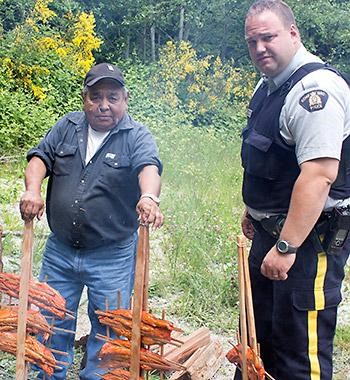Participants of a cultural awareness day hosted by Tla’amin (Sliammon) First Nation heard about the community’s experiences from pre-contact time to the devastation of residential schools.
The Sliammon Justice Program partnered with the RCMP, Police Based Victim Services, Specialized Victim Services and Stopping the Violence Outreach programs to present the event. The goal was to build and strengthen partnerships, knowledge and awareness as community members, first responders and service providers work together.
After a ceremonial procession into the Salish Centre, songs and an opening prayer, Tla’amin Chief Clint Williams welcomed participants. Erik Blaney and Georgia Combes gave a presentation on the Tla’amin Guardian Watchmen program, which started up as a natural resource monitoring strategy and expanded to include archaeological site protection in March 2012.
Erik talked about the importance of sites to the community. “Sliammon can actually bring their youth back to these sites and their ancestors are laid to rest where they belong, where they are supposed to be,” he said. “They have teachings, knowledge for us.”
On a trip to Cochrane Bay, a large site that has many items and areas of significance, Erik said his brother, Drew, sat in the depression of a long house. He heard a song from far away and started drumming with a stick. Erik grabbed his smartphone and took a video of Drew drumming and singing. That song is now one of the traditional songs the community sings at events.
Dana Lepofsky, a professor of archaeology at Simon Fraser University (SFU), provided information about the work the department has been doing in the area for the past six years. The University of Saskatchewan has also done work in the area.
“Not surprising, there are sites everywhere on this landscape,” Lepofsky said. “Keeping these sites intact, in their place, in their context is just the only way we get a little window into the knowledge and traditions that were involved in those sites.”
Elder Eugene Louie spoke about colonization and the impact of residential schools and Johnny Louie, an elder advisor, spoke about traditional healing wellness practices.
The event included lunch, which was followed by traditional and cultural displays and demonstrations, such as basket weaving, carving, barbequed salmon, Tla’amin language, maps of traditional territories and traditional practices like cedar bow brushing.



